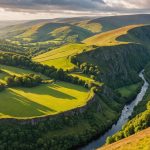Uncover Scotland’s Rich Heritage: Explore Historic Sites Linked to the Jacobite Uprising
Scotland, with its rugged landscapes and rich history, is a treasure trove of historical sites that tell the story of the Jacobite uprising, a pivotal period in Scottish history. This article will guide you through some of the most significant historic sites linked to the Jacobite rebellion, offering a deep dive into the history, significance, and what to expect when you visit these places.
The Jacobite Uprising: A Brief History
Before we delve into the specific sites, it’s essential to understand the context of the Jacobite uprising. The Jacobite risings were a series of rebellions that took place in the late 17th and 18th centuries, aimed at restoring the House of Stuart to the British throne. The most famous of these risings was the 1745 rebellion led by Charles Edward Stuart, commonly known as Bonnie Prince Charlie.
This might interest you : Exploring liverpool’s titanic ties: historic landmarks associated with the tragic voyage
Culloden Battlefield: The Final Stand
Location and Historical Significance
Culloden Battlefield, located near Inverness in the Scottish Highlands, is one of the most somber and significant sites related to the Jacobite uprising. This is where the final battle of the 1745 Jacobite rising took place on April 16, 1746. Here, the Jacobite forces led by Bonnie Prince Charlie were decisively defeated by the British government army, marking the end of the Jacobite aspirations to restore the House of Stuart to the throne[1][4][5].
Visitor Experience
Visitors to Culloden Battlefield can immerse themselves in the history of the site through the visitor center, which offers an immersive 360-degree battle immersion theater, period artifacts, and narratives from both the Jacobite and government perspectives. The battlefield itself is marked with graves and memorials, providing a powerful and moving encounter with Scotland’s turbulent history. Guided tours are available, and the site is open year-round, making it a must-visit for anyone interested in Scottish history[1][4][5].
Also to discover : Embark on a culinary journey: your essential guide to london”s must-taste british street food delights
Stirling Castle: A Fortress of Scottish History
Historical Importance
Stirling Castle, situated in the heart of Scotland, is another magnificent fortress that holds immense historical significance. It has been the focal point of many pivotal events in Scottish history, including the Wars of Scottish Independence. The castle played a crucial role in the Battle of Bannockburn in 1314, where Robert the Bruce secured a decisive victory against the English[1].
Visitor Highlights
Today, visitors can explore the castle’s exquisite Renaissance architecture and beautifully restored royal apartments, which offer a glimpse into the opulence of the past. The Great Hall and the Royal Chapel are must-see attractions, along with the breathtaking views from the castle’s ramparts. Interactive exhibits and guided tours further enhance the visitor experience, making Stirling Castle a key stop on any Scottish historical itinerary[1].
Blair Castle: Besieged Amid the Jacobite Risings
Siege and Legacy
Blair Castle, nestled in the stunning Scottish Highlands, endured a dramatic siege in 1746 during the last Jacobite Rising. Government forces defended the castle against Jacobite troops, highlighting the castle’s role in the tumultuous history of the region. Today, visitors can walk the storied grounds and discover exhibits that delve into its military legacy[3].
Visitor Experience
The castle’s history is palpable as you explore its halls and grounds. Exhibits provide a detailed look at the siege and the broader context of the Jacobite risings. Blair Castle is a testament to Scotland’s turbulent past and offers a unique insight into the struggles and triumphs of the time[3].
Urquhart Castle: A Fortress on Loch Ness
Historical Significance
Urquhart Castle, located on the shores of Loch Ness, has a history spanning over 1,000 years. It played significant roles in the Wars of Scottish Independence and various conflicts involving the powerful Clan Grant. The castle’s imposing stone ruins tell stories of medieval warfare and clan rivalries[1].
Visitor Highlights
Visitors can explore the castle’s towering gatehouse, the remains of the Great Hall, and climb Grant Tower for stunning views over Loch Ness. The visitor center provides informative exhibits and a short film that chronicles the castle’s tumultuous history. The location along Loch Ness also makes it an ideal spot for those interested in the legend of the Loch Ness Monster, combining myth with history for an unforgettable visit[1].
Dunnottar Castle: Scotland’s Impenetrable Stronghold
Dramatic Setting and History
Dunnottar Castle, perched on a rocky cliff overlooking the North Sea, is known for its dramatic setting and tumultuous history. During the Wars of Scottish Independence, this fortress was a critical defensive site. In the 17th century, it safeguarded the Honours of Scotland (the Scottish Crown Jewels) from Oliver Cromwell’s forces[3][5].
Visitor Experience
Walking through the ruins of Dunnottar Castle, you can almost hear the whispers of battles fought to preserve Scotland’s heritage. The castle’s history is rich with stories of sieges and defenses, making it a fascinating site to explore. The location itself is breathtaking, offering panoramic views of the North Sea[3][5].
Planning Your Tour: Practical Insights and Itinerary
Choosing the Right Tours
When planning your tour of these historic sites, it’s crucial to choose tours that offer a comprehensive and immersive experience. For Culloden Battlefield, consider a guided tour that includes the visitor center and the battlefield itself. For Stirling Castle, opt for a tour that includes interactive exhibits and access to the royal apartments[1][4][5].
Day Tour Itinerary
Here’s a suggested day tour itinerary to help you make the most of your visit:
- Morning: Start your day with a visit to Culloden Battlefield. Spend a few hours exploring the visitor center and walking the battlefield.
- Afternoon: Head to Urquhart Castle, where you can explore the ruins and enjoy the views over Loch Ness.
- Evening: End your day with a visit to Stirling Castle, taking in the evening views from the ramparts and exploring the castle’s historical significance.
Private Tours
For a more personalized experience, consider a private tour. These tours can be tailored to your interests and provide a deeper dive into the history and significance of each site. A private tour guide can also offer insights and anecdotes that might not be available on a standard group tour[2].
Table: Comparative Overview of Historic Sites
| Historical Site | Location | Highlights |
|---|---|---|
| Culloden Battlefield | Near Inverness | Jacobite history, immersive visitor center, war graves |
| Stirling Castle | Stirling | Renaissance architecture, Battle of Bannockburn, interactive exhibits |
| Blair Castle | Scottish Highlands | Siege during Jacobite Rising, military legacy exhibits |
| Urquhart Castle | Loch Ness | Medieval ruins, Grant Tower, Loch Ness views |
| Dunnottar Castle | North Sea Coast | Dramatic setting, safeguarded Scottish Crown Jewels, panoramic views |
Detailed Bullet Point List: What to Expect at Each Site
-
Culloden Battlefield:
-
Immersive 360-degree battle immersion theater
-
Period artifacts and narratives from both Jacobite and government perspectives
-
Marked graves and memorials
-
Guided tours available
-
Visitor center with interactive exhibits
-
Stirling Castle:
-
Exquisite Renaissance architecture
-
Beautifully restored royal apartments
-
Great Hall and Royal Chapel
-
Breathtaking views from the castle’s ramparts
-
Interactive exhibits and guided tours
-
Blair Castle:
-
Dramatic siege history during the Jacobite Rising
-
Exhibits delving into the castle’s military legacy
-
Storied grounds and halls
-
Detailed look at the siege and broader Jacobite context
-
Urquhart Castle:
-
Towering gatehouse and remains of the Great Hall
-
Grant Tower with stunning views over Loch Ness
-
Informative exhibits and short film on the castle’s history
-
Combination of myth and history with the Loch Ness Monster legend
-
Dunnottar Castle:
-
Dramatic setting on a rocky cliff overlooking the North Sea
-
Critical defensive site during the Wars of Scottish Independence
-
Safeguarded the Scottish Crown Jewels
-
Panoramic views of the North Sea
-
Ruins that tell stories of battles fought to preserve Scotland’s heritage
Quotes and Anecdotes
-
“Culloden is such an important part of Scottish and English history. I’m fascinated by the Jacobites and their cause and am trying to learn more. This is a cause that divided families so there are many stories,” – A visitor to Culloden Battlefield, highlighting the site’s significance and personal connection[5].
-
“Walking through the ruins of Dunnottar Castle, you can almost hear the whispers of battles fought to preserve Scotland’s heritage,” – A description that captures the essence of visiting Dunnottar Castle, emphasizing its historical and atmospheric value[3].
Scotland’s historic sites linked to the Jacobite uprising offer a rich tapestry of history, drama, and beauty. From the somber Culloden Battlefield to the majestic Stirling Castle, each site provides a unique window into Scotland’s turbulent past. Whether you choose to explore these sites on a guided tour or venture out on your own, the experience is sure to be both enlightening and unforgettable.
As you plan your itinerary, remember to take your time, absorb the history, and let the stories of these sites come alive around you. Scotland’s heritage is a treasure that awaits your discovery, and these historic sites are just the beginning of an incredible journey through time.











